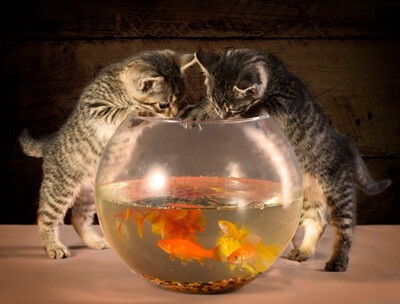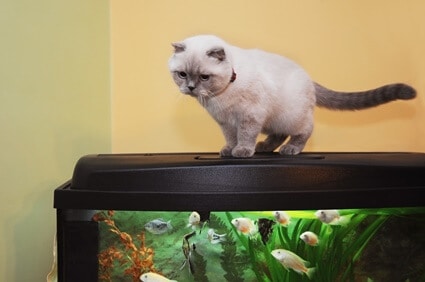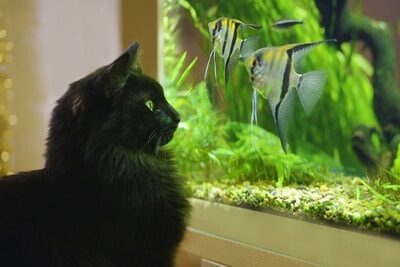Cats and fish tanks can be a tricky combination. By introducing these two pets to the home, you’re combining predator and prey. Given the chance, cats will stalk and hunt fish as they’re fascinated by their eye-catching colors and movements. So, you must take precautions to keep your cat out of the fish tank.
Cat-proof a fish tank by making high surface points inaccessible. The lid must be securely fastened to the tank so that feline paws can’t access it. Put double-sided sticky tape or aluminum foil on the surface where the tank rests, and store away any fish food that may attract a cat’s attention.
When cats and fish are kept apart, they can co-exist in the same home. Aquariums, fish tanks, and bowls can be an endless source of visual entertainment for cats. You just need to keep your pets safe by taking precautions.
Why Do Cats Like Fish Tanks?
Many owners find that their cats are obsessed with watching fish in an aquarium and want to gain an eye-level vantage point. While most cats detest water, there are various reasons why cats are interested in fish tanks.
These include the following:
Colors and Movement
Feline vision responds to stimulation, including bright colors and sudden movements. The more exotic the fish and the greater the number of fish, the more fascination an aquarium will provoke.
Fish will pique a cat’s curiosity because they’ll constantly make small, jerky motions. Your cat will be quick to investigate the source of activity, discovering the numerous inhabitants of the tank.
Warmth
Depending on the fish you keep, your tank may be heated. If so, the heat will rise. This will make the lid of a fish tank warm and cozy for a cat. Your cat may lie on the fish tank lid because it enjoys the warmth.
While this will be a welcome respite from the winter chill, it must be avoided. Your cat will frighten the fish and may fall into the tank. There’s even a risk that the cat will burn its skin through prolonged exposure.
So, ensure that your cat has a more appropriate heat source during the colder months.
Hunting
Never underestimate feline hunting instincts as a predatory cat may eat fish from the tank. However, this is more likely in cat breeds that are expert hunters, such as the American Shorthair or Maine Coon.
As explained by bioRxiv, cats are patient when hunting fish, contented to lie in wait and pick off shallow swimming fish. Given that fish are confined to a small amount of space, this makes pet fish easy prey for most cats.
Running Water
Cats dislike drinking still water from a bowl.
However, cats are interested in drinking from a fish tank. That’s because the sound of moving water created by the air pump creates the illusion of freshness.
The cat will frighten the fish by drinking from the tank. The other problem is that a cat may swallow stagnant water or fish feces and become ill due to a bacterial infection.
Do what you can to muffle the sound of this running water and offer your cat an alternative source of hydration, such as a water fountain. Cats are even attracted to drinking water from a running toilet.
Unclaimed Territory
Both cats and fish are territorial animals but occupy different spaces. The underwater domain of a fish is of no interest to a cat, but a fish tank can be claimed as territory via scent marking.
Some cats will claim a fish tank as a place to nap and relax, even if they have little interest in the fish.

How To Protect Fish from Cats
If you’re keeping cats and fish as pets, you’ll need to cat-proof your fish tank. Primarily, this is to protect your fish. The more the cat stalks the tank, the more stress the fish will feel.
If your cat falls in a fish tank, it’ll get soaked and could develop hypothermia. Although less likely, a cat could drown.
Fish Tank Relocation
A cat will climb on top of a fish tank if given the opportunity. The harder you make this task, the less likely it is to happen. The higher up the tank, the less accessible the tank will be to cats.
Limit the cat’s ability to reach the fish tank by reducing the number of launching pads. Don’t locate any furniture, such as sofas, tables, and sideboards, near the aquarium.
A standing jump will only take a cat so far, and cats know their physical limitations.
Seal The Fish Tank
Most quality fish tanks will be fitted with a lid.
These will contain small holes for air and feeding. Usually, they’re far too small for a cat’s paws. However, small gaps can be made larger with continuous and determined clawing.
Once the lid is in place, ensure that it’s secure. You can tape down the lid if there are air holes and feeding slots. Use strong, electrical standard tape, and make it impossible for a cat to cut the tape with its claws.
Consider weighing down the lid, but be careful as cats knock items over for various reasons. Whether by accident or design, this can be dangerous for your cat, fish, and family.
Add netting below the lid. If your cat manages to open the lid, it won’t be able to snatch the fish with its paws.
Unappealing Textures
Cats dislike sticky sensations as they cling to the paw pads and feel uncomfortable.
You can keep your cat away from a fish tank with double-sided sticky tape. Also, cats dislike aluminum foil due to the shiny, cold material under their paws.

Ultrasonic Devices
Playing sounds that cats dislike can keep cats away.
According to Hearing and Sound Communication in Fishes, fish have poor hearing, so noise is unlikely to upset aquatic pets. Consider an ultrasonic device on a low volume setting.
Cover The Fish Tank
If you’re unavailable to supervise your cat because you’re asleep, shopping, or at work, cover it up. If the cat cannot see the fish tank, it’s less likely to show interest. Just put a breathable towel or blanket over the tank.
Distraction Techniques
If your cat insists on circumnavigating your deterrents, you’ll need to distract it yourself.
Effective techniques include:
- Loud noises, such as handclaps or whistles
- Vocal commands, like a stern, “no”
- Offering playtime with a favored toy
When your cat stops interacting with the fish tank, offer it an incentive. This could be food, catnip, or petting – whatever your cat values most. Make it worth the cat’s while to cease interacting with the fish tank.
There’s no reason why you can’t have fish and cats living in the same home, provided that you cat-proof the fish tank and position it in a location that’s not easily accessible.

